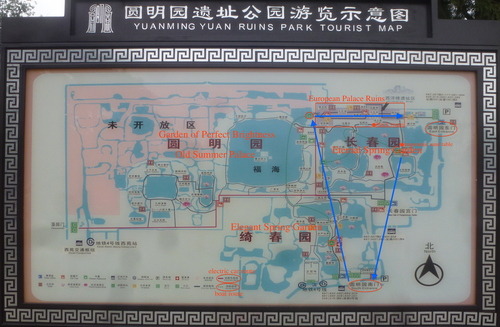All About That Old Summer Palace (圆明园-Yuanmingyuan)
Which metro stop? Line 4, Yuanmingyuan Station, Exit B

Ticket Information
The through ticket, as opposed to just the entrance ticket, includes: entrance (门票), European palace ruins (遗址区), and the panoramic sand table (全景沙盘)

*Free (just entrance): kids 65, military and dependents, disabled, courageous and kind people, model government workers, retired people, and injured military
*50% discounts (just entrance): kids 6-18, full time college students (not including post grad), seniors 60-64, and those on Beijing’s minimum living allowance
*All discounts require official certification as proof
Boat Route: South gate – transfer – European Palaces Ruins West entrance (20元)
Electric car route: see pink line on map (6元; 3元 for kids

Hours

Personal Recommendation
Having spent a thoroughly exhausting day exploring the entirety of the Old Summer Palace, which is about the same size as New York’s Central Park, I can tell you that the ruins of the European Palaces are without a doubt the highlight. I recommend going straight there and straight back otherwise your whole day will be gone, you’ll have seen the same scenery, and probably have gotten lost. On your way to the ruins, you will get a general impression of what the rest of the massive park looks like. Outside of the ruins, I also recommend the black swan viewing area and the panoramic sand table, which is included in the through ticket. Both of these you can see either on the way to or on the way from the ruins by following the park signs.
The Old Summer Palace, often referred to in Chinese as 圆明园 actually consists of three separate garden: 圆明园 meaning Garden of Perfect Brightness, 长春园 meaning Eternal Spring Garden, and 绮春园 meaning Elegant Spring Garden. Like I said, the small European Palace Ruins area (西洋楼) is the most interesting part of the expansive Old Summer Palace. This area, which you do need a ticket to get into, is in the north of the Eternal Spring Garden and spans 70,000 square meters. Planning began in 1747 under the reign of emperor Qianlong and construction was finished in 1759. The Italian painter, Giuseppe Castiglione, and French missionary, Michel Benoist, were instrumental to the design of the European Palaces. Imperial court paint, Yi Lantai, made a set of 20 elevation perspective architectural drawings on copperplates, which is part of the reason why, even now after such destructions, we still have a good idea of what these buildings once looked like. The European Palaces fared better than their counterparts due to the fact that they were mostly constructed from stone.


If you enter from the West entrance (there are two entrances: East and West), you will first come upon the ruins of the Harmonious Wonder (谐奇趣), which you can scramble upon and see the intricately carved rococo motifs in broken pieces on the ground. It is odd to see such a beautiful design broken in pieces on the barren ground; it just seems unnatural. It makes you wonder what this place used to look like; after all, it was once considered the Versailles of the East. In its heyday, this pile of rubble was once a three-story building with two beautiful European-style fountains in the front (the south) including a crab-apple shaped fountain with water columns jetting from copper sheep, copper ducks, and up-tailing stone fish, and a smaller Chrysanthemum shaped fountain.


Next you will see my utmost favorite part of the whole garden, the stone labyrinth. In Chinese it is called 黄花阵 meaning “yellow flower maze” or 万花阵 meaning “10,000 flower maze.” It is exactly what it sounds like. The walls are only 4 feet high and adorned with the Buddhist swastika. The outer walls are 1.6 km in length. The four corners of the maze have 4 trees that form a canopy almost creating a hidden room. There is a beautiful octagonal stone pavilion sitting on a raised circular foundation in the center of the rectangular maze. This was not accidental. In Chinese culture, roundness represents the sky, which is why the Temple of Heaven is circular, however squares represent the earth, which is why the Temple of Earth is a square. In this maze, the architectural symbolism tells us that heaven sits above earth.
According to historical records, the emperor would hold a lantern party on the evening of the Moon Festival each year. Emperor Qianlong would playfully chase his lantern-holding concubines through these confusing corridors. Try to ignore the tourists climbing on the walls and imagine that delightful scene when you are there.


Lastly, you will see the ruins of the Great Fountains (大水法). This is the most iconic image of the Old Summer Palace. Here once stood fountains that would put the Fountain of Trevi to shame. The fountain featured 10 hunting dogs chasing a male sika deer, all of these bronze beasts had water spraying out of their mouths in a way that I’m sure was appealing. This scene known to the Chinese as, quite literally, “hunting dogs chasing the sika deer,” but is known to Westerners as, more poetically, “the war of the beasts.”
Why is Yuanmingyuan in ruins?
See my next post :P